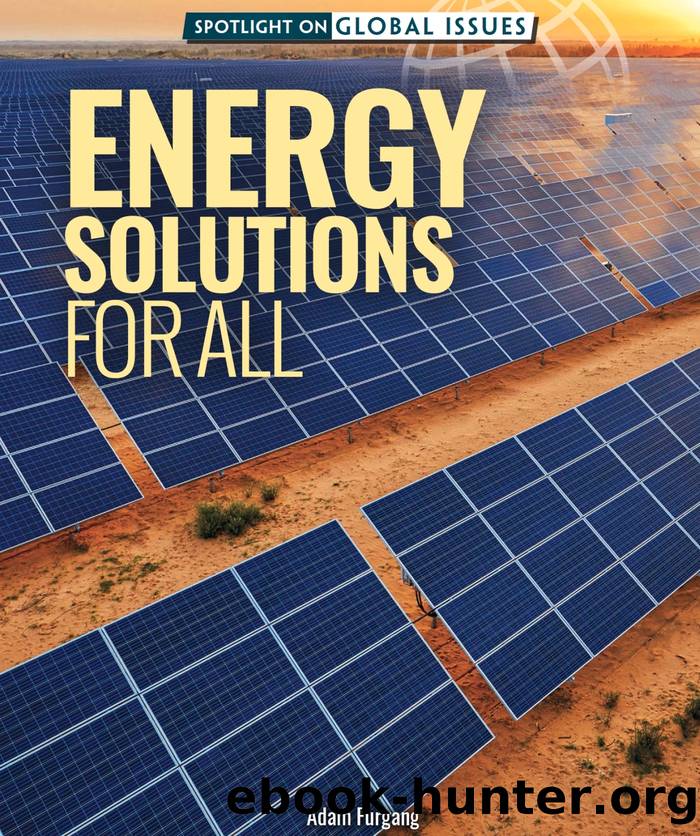Energy Solutions for All by Adam Furgang

Author:Adam Furgang
Language: eng
Format: epub
Publisher: The Rosen Publishing Group, Inc
Published: 2021-07-26T00:00:00+00:00
Assembly lines like this one at the Ford Motor Company plant in Highland Park, Michigan, revolutionized manufacturing and made automobiles more affordable.
For many years, the public was unaware of how carbon emissions contribute to global climate change. It wasnât until the 1970s that the growing environmental movement began to spread concern over and mindfulness about peopleâs impact on Earthâs climate. During the late 1980s, increased media coverage helped improve public awareness about global warming.
As people started to move away from using forms of fossil fuels for energy, electric-powered vehicles began gaining popularity. The first massproduced hybrid electric vehicle was the Toyota Prius, released in Japan in 1997. A hybrid vehicle has a gasoline engine and an electric motor. In 2003, a group of engineers created the company Tesla Motors. Tesla now sells emission-free, battery-powered electric vehicles.
Despite growing awareness about climate change and progress in developing alternative energy sources for vehicles, thereâs still a long way to go. All forms of transportation combined to generate almost 25 percent of the worldâs greenhouse gas emissions in 2018.
Saving and storing electricity so it wonât go to waste is an important step in lowering power costs and reducing harmful emissions.
After electricity is generated at a power plant, not all of it gets used. Some of the electricity goes to waste in transmission, or the process by which itâs sent out. Some gets wasted in the distribution, or delivery, process. Overall, 6 percent of generated electricity was lost in the United States in 2013.
Electric companies also generate electricity based on demand, but itâs not a perfect system. In order to always provide enough electricity, power plants generate more power than people actually need. The unused electricity sometimes goes to waste. There are several ways to store electricity, reducing this problem:
⢠Large batteries can store electricity to be used later.
⢠Machines pump water into reservoirs, or man-made lakes. When more electricity is needed, the water flows out, powering turbines and generators.
⢠Excess energy can be used to cool water or create ice. The cold water or ice is used to cool systems when demand increases.
⢠Kinetic energy can be stored by using large spinning devices called flywheels. Flywheel rotation can be used to power electric generators as needed.
Innovative energy storage solutions could help us limit our use of fossil fuels. Finding ways to conserve energy will be a key part of creating healthier energy practices in the future.
Download
This site does not store any files on its server. We only index and link to content provided by other sites. Please contact the content providers to delete copyright contents if any and email us, we'll remove relevant links or contents immediately.
The Giant and How He Humbugged America by Jim Murphy(3339)
The Science Book (Big Ideas Simply Explained) by DK(3182)
Harry Potter: A History of Magic by British Library(2980)
The Elements by Theodore Gray(2960)
A Short History of Nearly Everything by Bryson Bill(2585)
Make by Mike Westerfield(2260)
Easy Electronics by Charles Platt(2256)
The Astronomy Book by DK(2088)
The Cat in the Hat by Dr. Seuss(2082)
CLICK'D by Tamara Ireland Stone(1802)
Science Experiments You Can Eat by Vicki Cobb(1800)
Calling All Minds by Temple Grandin(1751)
The Crime Book (Big Ideas Simply Explained) by DK(1736)
03 The Prophet of Yonwood by Jeanne DuPrau(1733)
Think Like a Rocket Scientist by Ozan Varol(1726)
Pax by Sara Pennypacker(1694)
Minecraft by Mojang Ab(1693)
Martin Gardner's Science Magic by Martin Gardner(1660)
Getting Started with Soldering: A Hands-On Guide to Making Electrical and Mechanical Connections by Vinck Marc de(1612)
